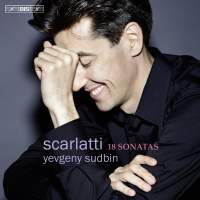Texte paru dans: / Appeared in: |
|
|
Outil de traduction ~ (Très approximatif) |
|
|
Reviewer: Barry
Brenesal “Playing Scarlatti on the piano is in effect a piano transcription, if not by name then by meaning, since Scarlatti’s keyboard instruments were clearly vastly different from the modern piano,” writes Yevgeny Sudbin, in the liner notes to this release. “Whether it is simply adding ornamentation or accentuating certain timbres, adding voices or chords: here, as a pianist, one is freed from the burden of scary terms such as historical performance practice.” There are points made in that pair of sentences that, however evenly expressed, will be seen as throwing down the gauntlet by some people who very much enjoy this music. It’s fair to say that to at least some of them, the idea of employing the piano’s full coloristic possibilities, as Sudbin does in the Sonata in G Minor, K 373, and his range of touch in the Sonata in the D-Minor Sonata, K 9, amounts to complete anachronism. To go beyond that, to actually alter the music in a manner upon repeat—which isn’t done with Scarlatti—becomes an act of desecration. Let’s be clear about the limits Sudbin sets himself from the start. He is not speeding up these works insanely, or adding a syncopated rock beat behind them, or interpolating post-bop chord progressions. If he were to do any of these things, it would be no doubt easy to write off this album as an act of cheap meretriciousness—or at the very least, as an attempt to put Scarlatti through a variety of Postmodernist stylistic prisms, as jazz pianist Chihiro Yamanaka does so brilliantly with Scott Joplin on her 2015 Blue Note release Syncopation Hazard. Instead, what we have here is a recording of Scarlatti sonatas tastefully performed and thoughtfully reconceived outside accepted Baroque norms. Consider the well-known Sonata in C Major, K 159. Sudbin performs the first of its two sections extremely well in what we would recognize as a fairly conventional approach, one that applies accenting, ornaments, and variations in dynamics much as we’ve come to expect (with allowances for interpretative differences between artists) over the last several decades. The only way he could be said to differ markedly from the Kirkpatrick score is in starting at a moderate level of volume instead of the marked piano, but that isn’t at all unusual for this work. With that first section’s repeat, however, Sudbin begins by dropping to pianissimo with the sustain pedal in full use, creating a distant bell-like effect for the first four measures; and at the 10th measure he introduces a brief rallentando. Where things really change is in the work’s signature leaps, which are written as a first group of three that rise repeatedly to G, then a second group of three that rise ever higher to G, B, and D, respectively. Sudbin faithfully reproduces this the first time around, but on the repeat of the first section, the third G in the first group get treated as an upper mordent, while the leap to the D that concludes the second group is replaced by a glissando from G to D. Given the reasonably chosen, consistent tempo, clean articulation, and perfectly even dynamics, none of this sounds meretricious or rushed. To the contrary, the impression is one of poised humor. One other instance will do, and again, we’ll turn to one of Scarlatti’s most often performed works. The Sonata in G Major, K 125, ends its first section in the Gilbert score on an appoggiatura on F in the right hand, which rises to the final cadence on G. Once again, the first run through is immaculate, characterful, and traditional by modern standards. The repeat, however, amidst a few added ornaments and some octave doublings, concludes with an extra bar. It turns the F appoggiatura into a series of four 16th notes at F that again rise to G—but all performed very softly, capped with a muted cadence that is silenced almost as quickly as it is stated. This is teasing reverence raised to the level of art. A listener relatively unfamiliar with Scarlatti’s sonatas and therefore unaware of the changes Sudbin introduces—not just in the repeats, but the application of the piano’s full sonority in a few select pieces—would no doubt enjoy this disc just as much as any other album of Scarlatti played on the piano; probably more so than some, given Sudbin’s combination of exuberance in faster pieces, effortless technique, and great attention to detail. (Check out the Sonata in C Minor, K 99.) But for someone who already knows and enjoys so many of these sonatas, they’ll either be seriously put off by their treatment here, or realize that Sudbin’s album assumes the nature of a fascinating dialogue between the pianist and the listener, abetted by the pianist’s respectful but sophisticated musical commentary.
It should be clear to everyone
by now how much I’m taken by Sudbin’s efforts here. This album could have
easily fallen over into tackiness. It did nothing of the sort. It can be
accused of neglecting the word for the spirit, yet gives us rather more of
the pointed wit and Hispanic lyricism of the originals than several
self-effacing, interchangeable piano renditions I’ve heard over the years.
| |
|
|
|
|
Cliquez l'un ou l'autre
bouton pour découvrir bien d'autres critiques de CD |
|




